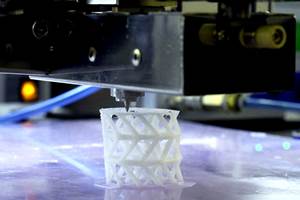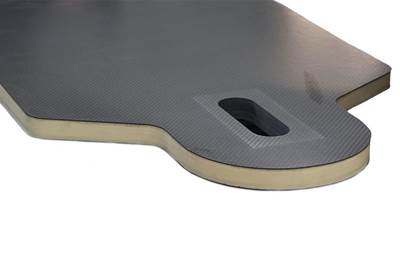Composites housing improves organ transport to save lives
Vabo Composites collaborates on novel design, supplies lighter, higher volume production housing.
A trusted supplier in the Dutch maritime industry for more than 20 years, Vabo Composites (Emmeloord) is best known for its lightweight yacht superstructures and serial production hatches and doors. That expertise in series composite products recently opened an altogether different opportunity in medical transport.
XVIVO (Gothenburg, Sweden) provides innovative technologies and services to preserve, transport and assess organs outside the body, giving more patients the chance to receive a life-saving transplant. The company’s Kidney Assist Transport is a portable device that enables hypothermic machine perfusion (HMP) — increasingly the standard of care when preserving and transporting kidneys — combined with continuous oxygenation. Results show this device provides kidney recipients with improved renal function, fewer graft failures and reduced incidence of acute rejection and severe complications post-transplant.
In 2023, XVIVO began a process to improve the design of the Kidney Assist Transport, which is manufactured to the company’s specifications by Unitron Systems (IJzendijke, Netherlands). This included the composite housing, which measures roughly 600 × 400 × 350 millimeters and was previously made using glass fiber and polyester resin in a hand layup process. XVIVO’s nearby R&D office in Groningen reached out to Vabo Composites to explore its options. “We have a good composites network in the Netherlands and were happy to work with XVIVO and Unitron to reengineer the housing in a way that would meet all of their requirements,” explains Vabo Composites personnel.
Vabo Composites manufactures the redesigned composite housing for XVIVO’s Kidney Assist Transport system using a type of light resin transfer molding (LRTM) process, enabling higher weekly production volumes.
XVIVO’s requirements included complex geometries that enable the multipiece unit to house a variety of components, open and close easily and provide significant thermal insulation, while meeting medical industry standards including use of an approved fire-retardant resin. Equally important was the need to enable serial production of multiple housings per week.
“The shape of the interior was very challenging,” notes Vabo Composites. The company worked with XVIVO and Unitron to complete the reengineering and validate both the new design and manufacturing process through a series of prototypes. Vabo was awarded a contract for production and celebrated the delivery of its 100th housing in October 2024.
Vabo Composites chose a modified resin transfer molding (RTM) process to make the housing. Specifically, it uses a kind of light RTM (LRTM) with a set of aluminum molds. Dry reinforcements and foam are placed into the molds, which are then closed and vacuum is applied. Resin is drawn into the cavity and cured to form the composite part. LRTM achieves good process control and dimensional stability as well as high productivity. “We were also able to reduce cycle time by using robot automation to speed layup of the complex shapes as well as trimming and drilling of holes,” says Vabo. This redesign of the process significantly reduced labor hours and scaled production.
The need for donated kidneys is increasing, and XVIVO is committed to making more organs available for patients in need. Its work with Vabo Composites makes this possible. “From the start, our engagement with the Vabo team was exceptional,” says Gunnar Ryrlen for XVIVO. “They have translated our requirements into a kidney transport box that is future-proof and aligned with our needs.”
Related Content
Generative Orthoses project to reshape orthopedic care
CRP Technology, MHOX and Istituto Ortopedico Rizzoli, one of the winners of the WORTH Partnership Project II, have developed bespoke orthoses using generative design, Windform GT fiberglass materials and PBF.
Read MoreFlux GmbH sponsors TUM Dash exoskeleton team
Flux to supply precision inductive rotary encoders for exoskeleton initiative for paraplegic patients that is expected to incorporate a future carbon fiber frame.
Read MoreSCABAEGO project develops bioactive composite that supports healing of broken bones
Fraunhofer IFAM researchers and partners combine biodegradable polymer polycaprolactone and bioactive glass to 3D print custom-fit structures for bone fracture sites.
Read MoreCevotec’s fiber patch placement is part of digital process chain for automated composite prosthetics
Multiple partners work to develop automated data collection, composite laminate generation for customized medical applications using FPP technology in German-funded Patch2Patient project.
Read MoreRead Next
CityAirbus NextGen to be developed for future medical missions in Norway
Airbus and the Norwegian Air Ambulance Foundation partner to measure the added value of eVTOL aircraft for medical use cases across Norway.
Read MorePost Cure: Natural mineral fiber biocomposite via AFP enhances implant integration
Arctic Biomaterials produces high-quality composite biomaterials incorporating a natural mineral fiber that is useful in medical and healthcare-related fields.
Read MoreComposite sandwich panels enable flexibility in medical table design
Polyurethane foam core provides a cost-effective option for ACP Composites’ specialized medical positioning table design.
Read More

























